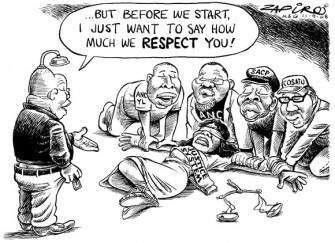Seedbags.
The new city of Cape Town logo that was approved yesterday despite fierce public opposition appears to have had a precedent in the form of a simple stationary company.
Waltons supplies Summit stationary, the box of which was sitting upon my desk. I wonder if the marketing company behind the new City of Cape Town logo had a box of seedbags sitting on their desk?
I took the liberty of overlaying the Summit logo over the City logo and found a remarkable fit. 97.3% fit to be exact. By scientific terms the probability of that happening by chance is almost inconceivable! I'm totally kidding of course. But here are some thoughts on the issue.
I don't think I'm mincing my words when I say the logo conjures up images of looking down a meat-grinder.
The logo resembles cogs. Is Table Mountain just another cog in the works? A money making machine for the city? The former logo was flowing - more natural. This is hard, angled and engineered. Is there no room left in the new city dispensation for nature any more, or is nature going to only be allowed to survive if its planned and engineered soon?
Recalls to mind a scene I passed on the highway into town. The city cutting back the unruly sour figs that were spilling over the side of the wall and daring to encroach on the sharp lines of the brickwork. Actually it reminds me of the last vestiges of my guerilla gardening of some 20 rare species that were finally brushcut to non-existance two weeks ago next to the highway.
The steam-rolling out of the new logo at least is in keeping with their new motto - "Making progress possible. Together". It seems though that they forgot to ask a crucial question: is the progress is desirable, and at what cost - financial and otherwise?
So what does The Naked Bloganist think about the new logo? It doesn't matter what I think, because the logo was approved yesterday, the roll-out of the new logo will happen, and all the sheeple will be part of the governmental meat grinder, proudly sporting their new logo on uniforms, stationary, websites, banners, billboards... at a currently estimated cost of R7 million.
TNB
Twitter: @TNBloganist
The new city of Cape Town logo that was approved yesterday despite fierce public opposition appears to have had a precedent in the form of a simple stationary company.
Waltons supplies Summit stationary, the box of which was sitting upon my desk. I wonder if the marketing company behind the new City of Cape Town logo had a box of seedbags sitting on their desk?
 |
| The logos of the City of Cape Town with a stationary logo on the right overlaid. Prices below reflect the estimated concept and design cost. |
I don't think I'm mincing my words when I say the logo conjures up images of looking down a meat-grinder.
The logo resembles cogs. Is Table Mountain just another cog in the works? A money making machine for the city? The former logo was flowing - more natural. This is hard, angled and engineered. Is there no room left in the new city dispensation for nature any more, or is nature going to only be allowed to survive if its planned and engineered soon?
Recalls to mind a scene I passed on the highway into town. The city cutting back the unruly sour figs that were spilling over the side of the wall and daring to encroach on the sharp lines of the brickwork. Actually it reminds me of the last vestiges of my guerilla gardening of some 20 rare species that were finally brushcut to non-existance two weeks ago next to the highway.
The steam-rolling out of the new logo at least is in keeping with their new motto - "Making progress possible. Together". It seems though that they forgot to ask a crucial question: is the progress is desirable, and at what cost - financial and otherwise?
So what does The Naked Bloganist think about the new logo? It doesn't matter what I think, because the logo was approved yesterday, the roll-out of the new logo will happen, and all the sheeple will be part of the governmental meat grinder, proudly sporting their new logo on uniforms, stationary, websites, banners, billboards... at a currently estimated cost of R7 million.
TNB
Twitter: @TNBloganist
































